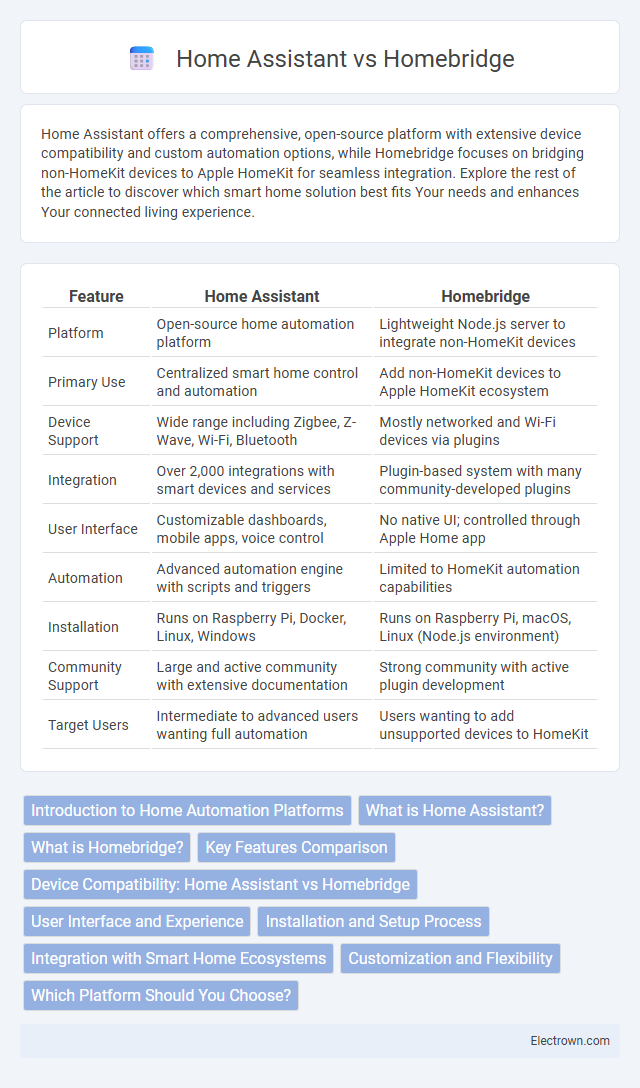Home Assistant offers a comprehensive, open-source platform with extensive device compatibility and custom automation options, while Homebridge focuses on bridging non-HomeKit devices to Apple HomeKit for seamless integration. Explore the rest of the article to discover which smart home solution best fits Your needs and enhances Your connected living experience.
Table of Comparison
| Feature | Home Assistant | Homebridge |
|---|---|---|
| Platform | Open-source home automation platform | Lightweight Node.js server to integrate non-HomeKit devices |
| Primary Use | Centralized smart home control and automation | Add non-HomeKit devices to Apple HomeKit ecosystem |
| Device Support | Wide range including Zigbee, Z-Wave, Wi-Fi, Bluetooth | Mostly networked and Wi-Fi devices via plugins |
| Integration | Over 2,000 integrations with smart devices and services | Plugin-based system with many community-developed plugins |
| User Interface | Customizable dashboards, mobile apps, voice control | No native UI; controlled through Apple Home app |
| Automation | Advanced automation engine with scripts and triggers | Limited to HomeKit automation capabilities |
| Installation | Runs on Raspberry Pi, Docker, Linux, Windows | Runs on Raspberry Pi, macOS, Linux (Node.js environment) |
| Community Support | Large and active community with extensive documentation | Strong community with active plugin development |
| Target Users | Intermediate to advanced users wanting full automation | Users wanting to add unsupported devices to HomeKit |
Introduction to Home Automation Platforms
Home Assistant and Homebridge serve as pivotal home automation platforms designed to enhance smart device interoperability and user control. Home Assistant offers a comprehensive, open-source ecosystem supporting numerous devices and protocols with robust automation capabilities and advanced customization options. Homebridge acts as a lightweight intermediary, bridging non-Apple smart devices to Apple HomeKit, enabling seamless integration within the Apple ecosystem.
What is Home Assistant?
Home Assistant is an open-source home automation platform designed to centralize and control smart devices from various brands, enabling seamless integration and customization through a single interface. It supports a vast range of components, including lights, sensors, and media players, offering advanced automation capabilities powered by YAML scripting and a user-friendly dashboard. Your smart home experience becomes more cohesive with Home Assistant's local control, privacy-centric approach, and wide community support for continuous updates and new features.
What is Homebridge?
Homebridge is an open-source platform that allows non-HomeKit compatible smart home devices to integrate with Apple's HomeKit ecosystem, enabling control through the Apple Home app and Siri. It acts as a lightweight Node.js server that bridges various IoT devices by using plugins, expanding the range of smart devices accessible via HomeKit. This solution is ideal for users looking to unify disparate smart devices under a single Apple-centric interface without replacing existing hardware.
Key Features Comparison
Home Assistant offers comprehensive automation capabilities with native support for over 1,700 devices and platforms, providing advanced customization through YAML and a powerful automation engine. Homebridge primarily serves as a lightweight bridge to integrate non-HomeKit-compatible devices into Apple HomeKit, focusing on plugin-based extensibility rather than native automation features. Your choice depends on whether you prioritize a robust, all-in-one smart home controller (Home Assistant) or seamless Apple ecosystem compatibility with simple device bridging (Homebridge).
Device Compatibility: Home Assistant vs Homebridge
Home Assistant supports a vast range of devices from various manufacturers thanks to its open-source platform and extensive community integrations, making it highly versatile for smart home enthusiasts. Homebridge primarily focuses on bridging non-Apple-compatible devices to Apple HomeKit, ensuring seamless integration with Apple ecosystems but with a narrower device compatibility scope. Your choice between the two should consider whether you prioritize broad device compatibility or Apple-centric smart home integration.
User Interface and Experience
Home Assistant offers a highly customizable user interface with advanced dashboard options, enabling you to tailor your smart home controls to fit your preferences seamlessly. Homebridge provides a simpler, more straightforward UI focused on integration with Apple HomeKit, making it ideal for users who prioritize ease of use within the Apple ecosystem. Your choice between these platforms will largely depend on whether you seek deep customization (Home Assistant) or streamlined Apple device compatibility (Homebridge).
Installation and Setup Process
Home Assistant offers a comprehensive, all-in-one installation with official images for Raspberry Pi and Docker setups, supporting automated discovery of numerous smart devices for simplified configuration. Homebridge requires Node.js environment setup, manual installation via npm, and configuration through JSON files, emphasizing flexibility for integrating unsupported HomeKit devices. Both platforms provide extensive community support, but Home Assistant's native integrations reduce setup complexity compared to Homebridge's plugin-dependent approach.
Integration with Smart Home Ecosystems
Home Assistant offers extensive integration with a wide range of smart home ecosystems including Google Assistant, Amazon Alexa, Apple HomeKit, Zigbee, and Z-Wave, supporting over 1,800 compatible devices and platforms. Homebridge primarily focuses on bridging non-HomeKit devices to Apple HomeKit, enabling control of unsupported smart gadgets via Siri and the Apple Home app. Users seeking broad multi-ecosystem compatibility often prefer Home Assistant, while Homebridge is ideal for those heavily invested in the Apple ecosystem.
Customization and Flexibility
Home Assistant offers extensive customization through its open-source platform, supporting hundreds of integrations and allowing users to create complex automations tailored to specific needs. Homebridge provides a lightweight solution primarily focused on bridging non-HomeKit devices to Apple's ecosystem, with plugins enabling moderate customization but limited compared to Home Assistant's flexibility. Users seeking advanced control and diverse device compatibility often prefer Home Assistant for its robust customization options and adaptability.
Which Platform Should You Choose?
Home Assistant offers a comprehensive, open-source home automation platform with broad device compatibility and advanced customization through YAML scripting, ideal for tech-savvy users seeking robust control. Homebridge focuses on integrating non-HomeKit devices into Apple's HomeKit ecosystem, providing a simpler setup for users heavily invested in Apple products and wanting seamless Siri voice control. Your choice depends on whether you need extensive cross-platform automation with Home Assistant or straightforward Apple HomeKit integration via Homebridge.
Home Assistant vs Homebridge Infographic

 electrown.com
electrown.com